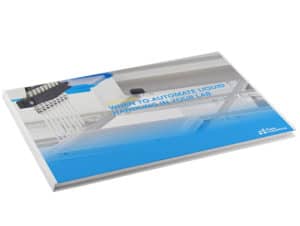5 Myths about lab automation
Automation that caters to all types of laboratories is a relatively new solution, and plenty of myths linger from way back when the instruments were large and rigid.
We did a little investigating to boil it down to the basics. Let us address some of the most common myths and their realities, based on conversations with our customers.
Myth 1:
The programming is time-consuming and difficult
This is among the most common misconceptions about lab automation.
Fortunately, some modern automation solutions can be programmed by anyone in a matter of minutes and save a large amount of time.

You quickly get started in the morning – a push on the button and it is ready to start running the predefined programs. It’s great that you don’t have to learn a lot of new procedures, it’s simple to use since you can set up programs with a few clicks, and everyone in our lab understood it right away.
Myth 2:
Each robot needs a superuser or programmer
This is another common misconception. Most robots are carefully designed to be intuitive and user-friendly.
Some systems can even be learned by anyone, no matter their prior experience.

We can easily program the robot to do exactly what we want. The staff had never worked with a robot before and they are very comfortable programming it and carrying out experiments with it.
Book a demo
Find out if automating your lab is possible and how much it would cost – book your personal demo today
Myth 3:
Lab automation is only worthwhile in laboratories with a large throughput
All laboratories can benefit from automation if they are doing time-consuming and repetitive manual pipetting tasks at least once a week.
In fact, smaller facilities with limited staff can have even more need for it to keep up with demand and utilize the staff’s full potential.

By changing to automated pipetting, we have been able to scale up from a couple of hundred tests analyzed to more than 1000 per day. We have also adjusted the robot to fit with our choice of tubes and volume quite easily, so we were able to switch smoothly from manual pipetting to the flowbot® ONE fast.
Myth 4:
A robot does not give as much flexibility as handheld pipetting when laboratory protocol change
Many systems are quite flexible and can easily adjust to new laboratory protocols. On top of that, some solutions can be customized to change between the procedures in specific laboratories.
But it is not always necessary to automate the entire lab. Sometimes it might make more sense to automate part of the workflow and only have a robot to do the heavy lifting so lab technicians can stay on top of other things.

Flexibility is important to us and, with the features that come with this robot, we have a system that adapts to our shifting pipetting procedures. We still have to explore the full potential of the robot, but with the great design of the user interface, this is something we are really looking forward to.
Myth 5:
Automation is an expensive investment
While a robot might seem like an expensive investment, you will most often save money long term when you factor in the manpower of manual pipetting and the increased productivity in the laboratory.
In fact, most laboratories find it to be a significant return on investment.

Especially on the cost-benefit ratio, it is excellent. It is probably one of the most effective liquid handling solutions for a frontline laboratory handling 2500 samples or more and very good for its size. The flowbot® ONE, with the very reasonable volume footprint, is even more attractive in a performance to size instrument because laboratory space is never enough.
Is lab automation something for you?
Then why don’t you get our free E-Book – here we address some of the advantages and disadvantages with lab automation and give you a checklist you can use for finding out if your lab is ready for automation.

